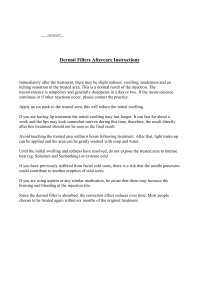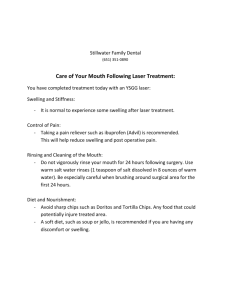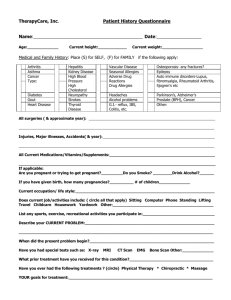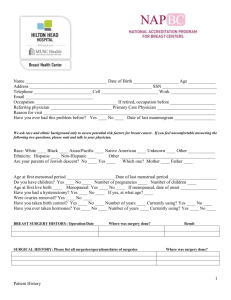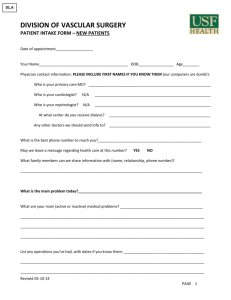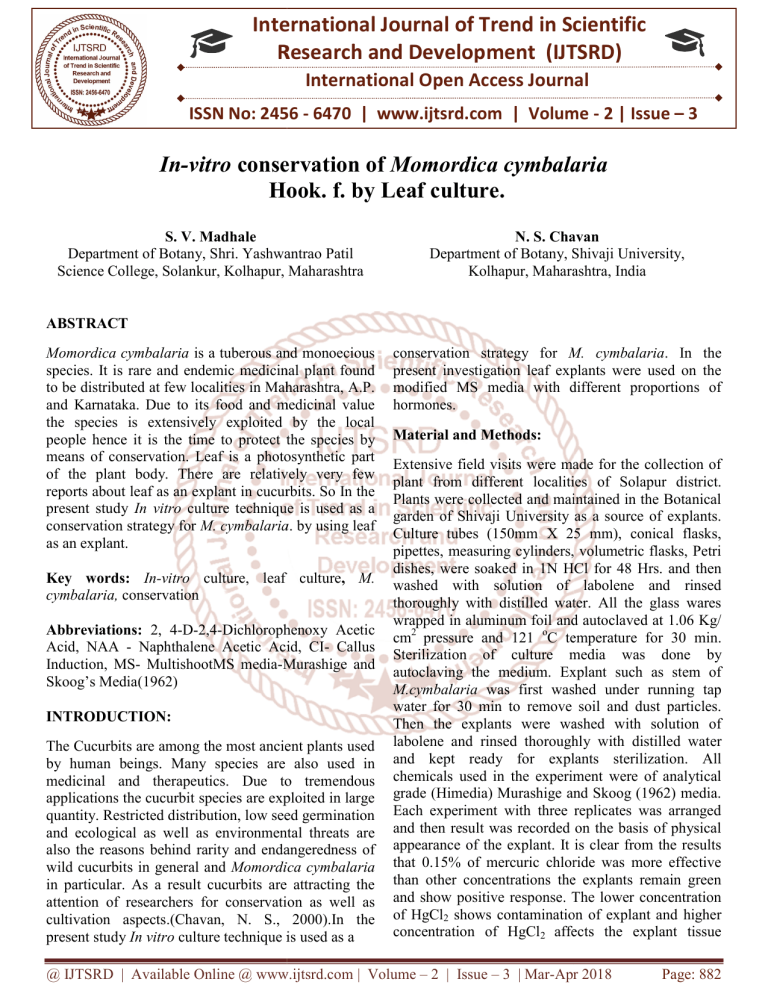
International Journal of Trend in Scientific Research and Development (IJTSRD) International Open Access Journal ISSN No: 2456 - 6470 | www.ijtsrd.com | Volume - 2 | Issue – 3 In-vitro conservation of Momordica cymbalaria Hook. f. by Leaf culture. S. V. Madhale Department of Botany, Shri. Yashwantrao Patil Science College, Solankur, Kolhapur, Maharashtra N. S. Chavan Department of Botany, Shivaji University, Kolhapur, Maharashtra, India ABSTRACT Momordica cymbalaria is a tuberous and monoecious species. It is rare and endemic medicinal plant found to be distributed at few localities in Maharashtra, A.P. and Karnataka. Due to its food and medicinal value the species is extensively exploited by the local people hence itt is the time to protect the species by means of conservation. Leaf is a photosynthetic part of the plant body. There are relatively very few reports about leaf as an explant in cucurbits. So In the present study In vitro culture technique is used as a conservation strategy for M. cymbalaria cymbalaria. by using leaf as an explant. Key words: In-vitro culture, leaf culture culture, M. cymbalaria, conservation Abbreviations: 2, 4-D-2,4-Dichlorophenoxy Dichlorophenoxy Acetic Acid, NAA - Naphthalene Acetic Acid, CI CI- Callus Induction, MS- MultishootMS media-Murashige Murashige and Skoog’s Media(1962) INTRODUCTION: The Cucurbits are among the most ancient plants used by human beings. Many species are also used in medicinal and therapeutics. Due to tremendous applications the cucurbit species are exploited in large quantity. Restricted distribution, low seed germination and ecological as well as environmental threats are also the reasons behind rarity and endangeredness of wild cucurbits in general and Momordica cymbalaria in particular. As a result cucurbits are attracting the attention of researchers for conservation as well as cultivation aspects.(Chavan, N. S., 2000).In the present study In vitro culture technique is used as a conservation strategy for M. cymbalaria. cymbalaria In the present investigation leaf explants were used on the modified MS media with different proportions of hormones. Material and Methods: Extensive field visits were made for the collection of plant from different localities of Solapur district. Plants were collected and maintained in the Botanical garden of Shivaji University as a source of explants. Culture tubes (150mm X 25 mm), conical flasks, pipettes, measuring cylinders, volumetric flasks, Petri dishes, were soaked in 1N HCl for 48 Hrs. and then washed with solution of labolene and rinsed thoroughly with distilled water. All the glass wares wrapped in aluminum foil and autoclaved at 1.06 Kg/ cm2 pressure and 121 oC temperature for 30 min. Sterilization of culture media was done by autoclaving the medium. Explant such as stem of M.cymbalaria was first washed under running tap water for 30 min to remove soil and dust particles. Then the explants were washed with solution of labolene and rinsed thoroughly with distilled water wat and kept ready for explants sterilization. All chemicals used in the experiment were of analytical grade (Himedia) Murashige and Skoog (1962) media. Each experiment with three replicates was arranged and then result was recorded on the basis of physical appearance of the explant. It is clear from the results that 0.15% of mercuric chloride was more effective than other concentrations the explants remain green and show positive response. The lower concentration of HgCl2 shows contamination of explant and higher concentration of HgCl2 affects the explant tissue @ IJTSRD | Available Online @ www.ijtsrd.com | Volume – 2 | Issue – 3 | Mar-Apr Apr 2018 Page: 882 International Journal of Trend in Scientific Research and Development (IJTSRD) ISSN: 2456-6470 adversely and it becomes brown. All the cultures were incubated in a growth room at relative humidity of 60% at the temperature of 24 ±2 oC under white fluorescent light (2000lux 16watt) provided by Phillips fluorescent tubes (TL40W/a cool day light). For the hardening of plantlets, plastic cups (5cm diameter) filled with autoclaved hardening mix of soil, sand and compost was used in various proportions. The explants were kept in culture room for two weeks to avoid desiccation after the plantlets were then transferred to 50% shade house for further hardening and then finally brought to field for general cultivation. Results and Discussion The MS- medium supplemented with BAP (3.0 mg/l) in combination with NAA (3.0 mg/l) showed swelling and caulogenesis (69%) in the leaf explants. The BAP (3.0 mg/l) in combination with NAA (3.0 mg/l) was proved to be effective for multishoot induction (Table No.-1).Similar kind of response of BAP and NAA in Cucumis sativus was observed by Josekutty et al., (1993);Sarmento et al., (1992) and Shirgave, (2003),Mehul G P., Kalpesh B. I. ( 2015)..The very high concentration and very low concentration of these two growth regulators did not influence positively. The plant material either shows swelling or remains green. The callus was also induced and proliferated (77%) on MS-I medium supplemented with BAP and 2, 4-D (3.0 mg /l each) in combination (Table No.2). The leaf explants cultured on MS-I medium enriched with NAA (3.0 mg /l) in combination with 2, 4-D (3.0 mg /l) shows callus induction as well as multishoot induction (77%) (Table No.-3).In the present experiment, the explant showed swelling and remain green with poor callus initiation in remaining combination of growth regulator. Conclusion The above result indicates that BAP has supplementary effect with NAA in callus initiation and multishoot induction and also NAA has supplementary effect with 2, 4-D in callus initiation and multishoot induction. However BAP with 2, 4-D influence only the initiation of callus. This kind of response with respect to supply of exogenous growth regulator exhibited species as well as organ specificity in culture Acknowledgments We are thankful to U.G.C. for funding the minor research project, entitled “in- vitro culture techniques in Momordica species.” Table No.1: Influence of BAP in combination with NAA on in vitro response of leaf explant of M. cymbalaria (Culture period 4 weeks) Growth regulators(mg/l) BAP NAA 0.1 1.0 0.5 1.0 1.0 1.0 2.0 1.0 3.0 1.0 4.0 1.0 5.0 1.0 % of cultures showing response ---------5.4±0.2 15.4±0.9 18.3±1.5 16.3±1.5 5.0±0.1 8.3±0.5 Morphological nature of explant / callus No response Remains green Swelling Swelling Swelling Remains green Remains green 0.1 0.5 1.0 2.0 3.0 4.0 5.0 2.0 2.0 2.0 2.0 2.0 2.0 2.0 6.3±0.5 10.8±0.2 14.7±0.8 14±0.6 12.2±0.5 21.0±0.2 8±0.2 No response Remains green Swelling Swelling Swelling Remains green Remains green 0.1 0.5 3.0 3.0 3.2±0.2 4.1±0.0 Remains green Remains green @ IJTSRD | Available Online @ www.ijtsrd.com | Volume – 2 | Issue – 3 | Mar-Apr 2018 Page: 883 International Journal of Trend in Scientific Research and Development (IJTSRD) ISSN: 2456-6470 1.0 2.0 3.0 4.0 5.0 3.0 3.0 3.0 3.0 3.0 7.2±1.0 64.5±1.1 69.0±0.2 7±0.4 5±0.1 Swelling Swelling,CI Swelling,CI,MS Remains green Remains green 0.1 0.5 1.0 2.0 3.0 4.0 5.0 4.0 4.0 4.0 4.0 4.0 4.0 4.0 2.3±0.0 3±0.2 5±0.0 11.3±0.3 9.2±0.1 6±0.2 2±0.2 Remains green Remains green Swelling Swelling Swelling Remains green Brown Table No. 3: Influence of NAA in combination with 2, 4-D on in vitro culture of leaf explant of M. cymbalaria (Culture period 4 weeks) Growth regulators(mg/l) %age of cultures showing Morphological nature of response explant / callus NAA 2,4-D 0.1 0.5 1.0 2.0 3.0 4.0 5.0 1.0 1.0 1.0 1.0 1.0 1.0 1.0 2.1±0.1 2.3±0.0 5±0.1 14±0.3 14±0.3 12±1.2 ---------- No response Remains green Swelling Swelling Swelling Remains green No response 0.1 0.5 1.0 2.0 3.0 4.0 5.0 2.0 2.0 2.0 2.0 2.0 2.0 2.0 2.5±0.1 9±0.5 14.5±0.1 56±2.7 64±1.5 21±0.72 7.2±1.5 No response Remains green Swelling Swelling,CI Swelling,CI Swelling No response 0.1 0.5 1.0 2.0 3.0 4.0 5.0 3.0 3.0 3.0 3.0 3.0 3.0 3.0 5±0.1 6±0.2 7±0.2 74±3.0 77±2.0 22±2.4 5±0.1 No response Remains green Swelling Swelling,CI Swelling,CI,MS Swelling No response 0.1 0.5 1.0 2.0 3.0 4.0 5.0 4.0 4.0 4.0 4.0 4.0 4.0 4.0 4.1±0.0 6.3±0.6 10±0.0 41±0.8 46±1.7 32±1.2 4±0.1 No response Remains green Swelling Swelling,CI Swelling,CI Swelling,CI Remains green @ IJTSRD | Available Online @ www.ijtsrd.com | Volume – 2 | Issue – 3 | Mar-Apr 2018 Page: 884 International Journal of Trend in Scientific Research and Development (IJTSRD) ISSN: 2456-6470 Table No. 3: Influence of NAA in combination with 2, 4-D on in vitro culture of leaf explant of M. cymbalaria (Culture period 4 weeks) Growth regulators(mg/l) %age of cultures showing response Morphological nature of explant / callus 2.1±0.1 2.3±0.0 5±0.1 14±0.3 14±0.3 12±1.2 ---------- No response Remains green Swelling Swelling Swelling Remains green No response NAA 0.1 0.5 1.0 2.0 3.0 4.0 5.0 2,4-D 1.0 1.0 1.0 1.0 1.0 1.0 1.0 0.1 0.5 1.0 2.0 3.0 4.0 5.0 2.0 2.0 2.0 2.0 2.0 2.0 2.0 2.5±0.1 9±0.5 14.5±0.1 56±2.7 64±1.5 21±0.72 7.2±1.5 No response Remains green Swelling Swelling,CI Swelling,CI Swelling No response 0.1 0.5 1.0 2.0 3.0 4.0 5.0 3.0 3.0 3.0 3.0 3.0 3.0 3.0 5±0.1 6±0.2 7±0.2 74±3.0 77±2.0 22±2.4 5±0.1 No response Remains green Swelling Swelling,CI Swelling,CI,MS Swelling No response 0.1 0.5 1.0 2.0 3.0 4.0 4.0 4.0 4.0 4.0 4.0 4.0 4.1±0.0 6.3±0.6 10±0.0 41±0.8 46±1.7 32±1.2 No response Remains green Swelling Swelling,CI Swelling,CI Swelling,CI 5.0 4.0 4±0.1 Remains green REFERENCES 1. Chavan, N. S. (2000). Ex-situ conservation of wild verities of cucurbits; Minor project submitted to Shivaji University, Kolhapur. 2. Josekutty, P. C., Shah, S. and Prathapasenan, G. (1993). Direct and indirect organogenesis in Coccinia indica, J.Hort. Sci. 68: 31-35. 3. Mehul G P., Kalpesh B. I. ( 2015). Momordica dioica Roxb. (Spine Gourd): Multiple 4. shoot induction from nodal cultures and its antidiabetic activity.Journal of Medicinal Plants Studies ; 3(6): 82-88 5. Murashige, T. and Skoog, F. (1962). A revised medium for rapid growth and bio-assays with tobacco tissue cultures. Physiol Plant 15: 473– 497. 6. Sarmento, G. G., Alpert, K., Tang, F. A. and Punja, Z. K. (1992). Factors influencing @ IJTSRD | Available Online @ www.ijtsrd.com | Volume – 2 | Issue – 3 | Mar-Apr 2018 Page: 885 International Journal of Trend in Scientific Research and Development (IJTSRD) ISSN: 2456-6470 Agrobacterium tumefaciens mediated transformation and expression of kanamycein resistance in pickling cucumber. Plant cell Tissue Org. Cult. 31: 185-193 7. Shirgave P. D. (2003). In vitro culture of Momordica dioica Roxb. Ex. Wild. A Ph.D. thesis, Shivaji University, Kolhapur @ IJTSRD | Available Online @ www.ijtsrd.com | Volume – 2 | Issue – 3 | Mar-Apr 2018 Page: 886

